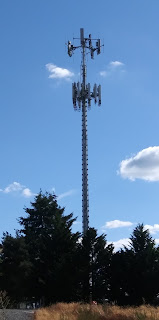On April 16, the Wireless Industry Association (WIA) released its report, "Wireless Infrastructure By The Numbers: 2023 Key Industry Statistics." As the title indicates, WIA's report provides a high-level look at the overall number of cell towers, macro sites, and small cell facilities that mobile service providers use to offer mobile broadband Internet access services. According to WIA's report, as of 2023, there were 153,400 cellular towers in operation in the U.S., in addition to nearly 245,000 macrocell sites and 202,100 outdoor small cells in operation. The report found that there also were nearly 776,000 indoor small cell nodes in use as of last year. These figures surely have grown since 2023.
Moreover, WIA's report found that "[t]he U.S. cellular industry spent $11.6 billion building additional capacity and coverage into the nation’s wireless networks in 2023." Another interesting observation in the report is that "[m]ore towers and cell sites are being deployed but the amount spent building networks is flat" because "[a]s wireless network technologies mature and evolve, network equipment becomes more efficient and cost effective." Also, "[t]he amount spent on maintaining and operating the cellular networks increased but build spending dropped" due to larger networks increasing the necessary maintenance costs.The deployment and operation of 4G LTE and 5G wireless networks depends on private market investment remaining strong. Subjecting mobile broadband networks to public utility regulation – as the FCC proposes in its Draft Order to be considered for a vote at the agency’s April 25 meeting – would undermine the ability of wireless infrastructure owners and operators to use their property and generate returns. This would reduce incentives to build and upgrade such infrastructure. The 2018 Restoring Internet Freedom Order found that the imposition of public utility regulation under the now-repealed 2015 Title II Order inhibited investment:
The Commission has long recognized that regulatory burdens and uncertainty, such as those inherent in Title II, can deter investment by regulated entities and, until the Title II Order, its regulatory framework for cable, wireline, and wireless broadband Internet access services reflected that reality. This concern is well-documented in the economics literature on regulatory theory, and the record also supports the theory that the regulation imposed by Title II will negatively impact investment. The balance of the evidence in the record suggests that Title II classification has reduced ISP investment in broadband networks, as well as hampered innovation, because of regulatory uncertainty. The record also demonstrates that small ISPs, many of which serve rural consumers, have been particularly harmed by Title II. And there is no convincing evidence of increased investment in the edge that would compensate for the reduction in network investment.
Imposing restrictions on 5G network slicing – either by outright prohibitions or by regulatory uncertainty under the vague "general conduct" standard contained in the Draft Order – also would be detrimental to wireless innovation and investment, including investment in the physical infrastructure that supports 5G uses. For more on this topic, see Free State President Randolph May's and Senior Fellow Andrew Long's April 2 Perspectives from FSF Scholars, "The 'Network Slicing' Debate Exposes How Title II Will Kill Innovation." Also, check out FSF President May's FSF Blog post from April 18: "Don't."




